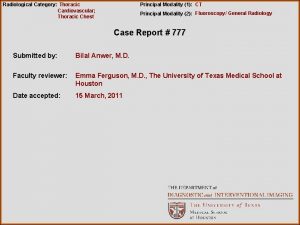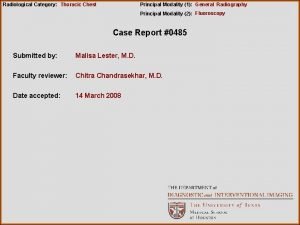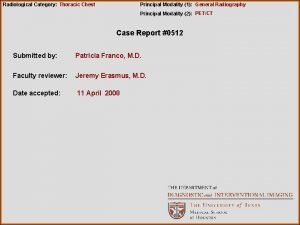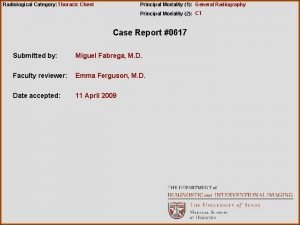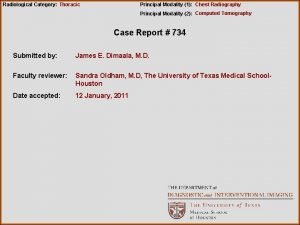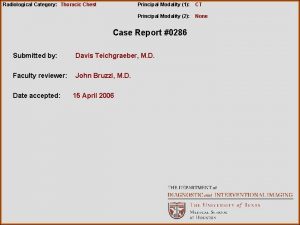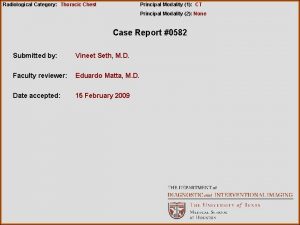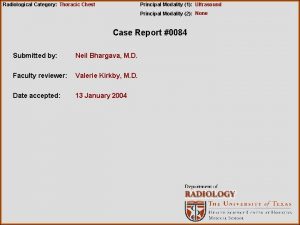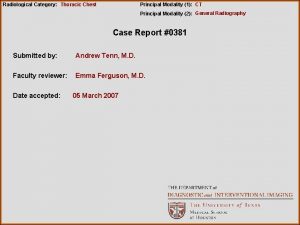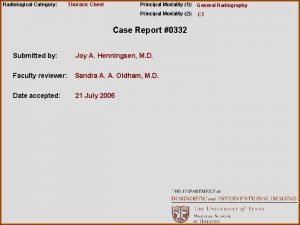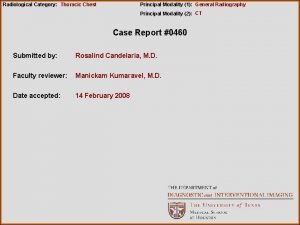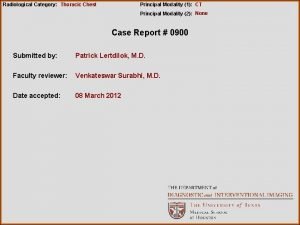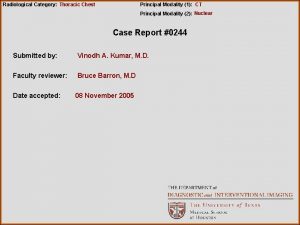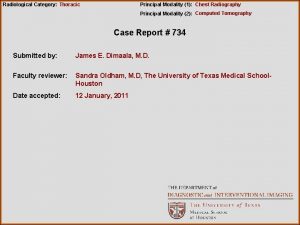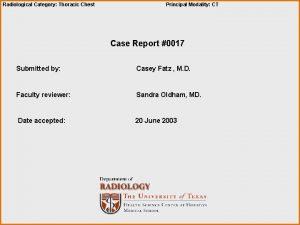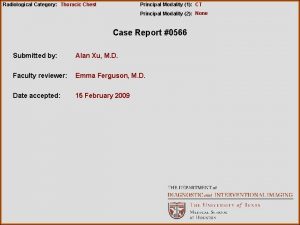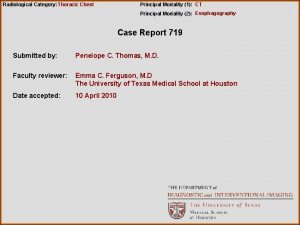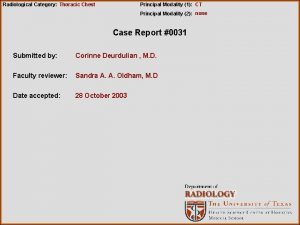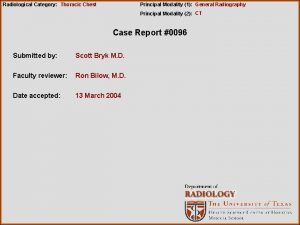Radiological Category Thoracic Cardiovascular Principal Modality 1 Chest

























- Slides: 25

Radiological Category: Thoracic Cardiovascular Principal Modality (1): Chest X-ray Principal Modality (2): CTA Chest Case Report 700 Submitted by: Bilal Anwer , M. D. Faculty reviewer: Emma Ferguson, M. D. The University of Texas Medical School at Houston Date accepted: 15 April 2010

Case History 31 year old male with 4 day history of chest pain, left sided facial weakness and malaise. PMHx: Hypertension and murmur. PSHx: None Soc. Hx: Negative FHx: Noncontributory Physical Ex: 4/6 holosystolic murmur in the left infra-clavicular region and hypertension in the upper extremities. Left sided Bell’s palsy.

Radiological Presentations: CXR

Radiological Presentations: CTA Chest in Sequence 1. 3. 2. 4.

Radiological Presentations: CTA Chest

Radiological Presentations: CTA Chest

Radiological Presentations: CTA Chest

Test Your Diagnosis Which one of the following is your choice for the appropriate diagnosis? After your selection, go to next page. • Chronic Aortic Dissection • Pseudo-Coarctation of Aorta • Chronic Large Vessel Arteritis (Takayasu Arteritis) • Aortic Coarctation

Radiological Presentations . The CXR shows bilateral inferior rib notching. Mildly prominent left heart border.

Radiological Presentations Multiple Collateral Vessels & Dilated Subclavian Arteries Dilated Internal Mammary & Costovertebral Arteries. Where is the Descending Aorta? Ascending & Descending Aorta Size Discrepancy

Radiological Presentations A Small Caliber Descending Aorta re-appears. Notice the Costovertebral Collateral Arteries Internal Mammary Arteries Supplying the Intercostal Arteries. Notice the Superior Epigastric Collaterals. Left Ventricular Hypertrophy

Radiological Presentations Intercostal Collateral Arteries With Resultant Inferior Rib Notching. Suprascapular Collaterals Supplying the Intercostal Arteries Aortic Valve Calcification

Radiological Presentations Stenosis of Aorta Past the Left Subclavian Artery Origin. Note the Intercostal Collaterals Draining into the Descending Aorta Past the Point of Stenosis

Findings and Differentials In summary, bilateral inferior rib notching and mild left ventricular prominence is noted on the CXR. On the CTA of the chest, there is left ventricular hypertrophy with calcification of the aortic valve. Post-left subclavian origin stenosis of the aorta is seen with dilated subclavian arteries supplying the internal mammary, costovertebral trunk, and suprascapular collateral vessels. These then supply the intercostal arteries that drain into the descending aorta distal to the stenosis. In addition, superior epigastric vessels also act as collaterals. Differentials: • Chronic Aortic Dissection • Pseudo-Coarctation of Aorta • Chronic Large Vessel Arteritis (Takayasu Arteritis) • Aortic Coarctation

Discussion In addition to the above findings, this young patient had an echocardiogram which showed left ventricular hypertrophy, aortic and mitral valve calcification with moderate to severe aortic regurgitation, moderate mitral valve regurgitation, and an ejection fraction of 65%. Chronic Aortic Dissection Chronic aortic dissections are usually asymptomatic and are associated with an aortic aneurysm. Presenting complaints can include dull, intermittent chest pain to sharp skeletal thoracic pain. Paralysis or paraplegia can result from embolization of thrombus. CT scan obtained at three-quarters distance along the length of the dissected portion of the aorta shows a flat dissection flap. Outer wall calcification (arrows) and thrombus (asterisk) are present in the false lumen (F). T = true lumen. Le. Page et al.

Discussion Pseudo-Coarctation of Aorta Pseudocoarctation of the aortic arch is a rare congenital anomaly characterized by one or more stenoses of the descending thoracic aorta immediately distal to the origin of the left subclavian artery. It results from elongation of aorta due to an unknown etiology. Since the aorta is fixed by the intercostal arteries and ductus arteriosus, the aorta rises and buckles at the insertion of the ductus arteriosus. Hypertension, dilated collaterals, delayed femoral pulses, and hemodynamic gradients are absent. Turbulence at the buckle can result in aneurysmal dilatation of the proximal The aortic arch has multiple calcified descending aorta. aneurysms (large arrows) and stenoses (small arrows). Sebastia et al.

Discussion Chronic Large Vessel Arteritis (Takayasu Arteritis) Chronic, granulomatous, progressive, large vessel inflammation involving the aorta and its major branching vessels. This can result in stenosis, occlusion, or poststenotic dilatation or aneurysm. The clinical manifestation is classically a triphasic pattern, with the late phase presenting with diminished or absent pulses, blood pressure discrepancy, vascular bruits, hypertension, and cardiac complications. There are six type of Takayasu’s arteritis depending on the location of aortic involvement. Coronal MIP 3 D MR angiogram shows stenosis at the origin of the right subclavian artery (small arrow). There is also diffuse narrowing of both common carotid arteries (arrowheads) and focal stenosis of the left subclavian artery (large arrow). Sagittal MIP 3 D MR angiogram from the same examination shows stenosis of the descending thoracic aorta (arrowhead). Nastri et al.

Discussion Aortic Coarctation The presentation and findings on the given patient fit this diagnosis. The Bell’s palsy was a red herring and improved in the hospital with anti viral and steroid therapy. A noncontrast CT head revealed no pathology. In addition to the findings in this patient, aortic coarctation can present as a double bulge at the proximal aorta or figure of 3 sign. Esophageal barium studies can diagnose it as a reverse 3 or E indentation onto the esophagus. Young patients may present in the first few weeks of life with poor feeding, tachypnea, and then progress to congestive heart failure. Late presentations usually consist of headache, hypertension in the upper extremities, and murmur. The pathophysiology behind the presentation is as follows: The murmur is usually secondary to a diseased bicuspid aortic valve. The increased afterload causes left ventricular hypertrophy and eventual heart failure. Hypertension results from an overactive renin-angiotensin system and catecholamines that the body produces to compensate for low flow. The collaterals become dilated and compensate for the lack of normal aortic flow.

Discussion Aortic coarctation can be pre-ductal or juxta-ductal/post-ductal or middle aortic type. Pre-ductal is the infantile form which represents diffuse hypoplasia or narrowing of the aorta from the brachiocephalic artery to the ductus. A patent ductus provides blood supply to the descending aorta. This patient has a post-ductal presentation, also known as adult type. Intraoperative picture demonstrating a post-ductal aortic coarctation. Omeje et al.

Discussion Figure of 3 sign on plain film Mc. Mohan & Singleton, Diagnostic Imaging Service, Texas Children’s Hospital Reverse figure of 3 or E sign on esophagram

Discussion Diagram of systemic thoracic (A and B), thoracoabdominal (B), and abdominal (C and D) collateral pathways in cases of aortic stenosis. In A, the thoracoacromial and descending scapular arteries (arising from the subclavian arteries) supply the poststenotic descending thoracic aorta with retrograde flow via the intercostal arteries. In B, the internal mammary arteries (arising from the subclavian arteries) connect both with the descending thoracic aorta via the intercostal arteries and with the external iliac arteries via the superior and inferior abdominal epigastric arteries. In C, the inferior intercostal arteries supply the external iliac arteries through the superficial and deep iliac circumflex arteries. In D, the lumbar arteries supply the internal iliac arteries via the inferior gluteal arteries. Sebastia et al.

Discussion Angiogram (AP view) showing severe postductal aortic coarctation with post-stenotic aneurysmal dilatation of the descending aorta and left ventricular hypertrophy. Knirsch et al. Depiction of collateral circulation at MR angiography and phase-contrast velocity-encoded cine MR imaging. MR angiograms show the intercostal (arrowheads) and internal mammary (arrow) arteries. Hom et al.

Diagnosis Aortic Coarctation, Post-ductal type.

References Donaldson MD, Gault EJ, Tan KW, Dunger DB. Optimising management in Turner syndrome: from infancy to adult transfer. Arch Dis Child. Jun 2006; 91(6): 513 -20 Marcio V. Nastri, MD, Luciana P. S. Baptista, MD, Ronaldo H. Baroni, MD et al. Gadolinium-enhanced Three-dimensional MR Angiography of Takayasu Arteritis. May 2004 Radio. Graphics, 24, Number 3, 773 -786. Kedareshwar PS Narvencar*, Ana Karina Jaques e Costa**, Vijaysinh R Patil*** Shone’s Complex 5/2009 JAPI. Rahiala E, Tikanoja T. Suspicion of aortic coarctation in an outpatient clinic: how should blood pressure measurements be performed? . Clin Physiol. Jan 2001; 21(1): 1004. Goldblatt H, Kahn JR, Hanzal RF. Studies on experimental hypertension. The effect on blood pressure of constriction of the abdominal aorta above and below the site of origin of both renal arteries. J Exper Med. 1939; 69: 649 -674. Mark A. Le. Page, Leslie E. Quint, Seema S. Sonnad, G. Michael Deeb and David M. Williams. Aortic Dissection: CT Features that Distinguish True Lumen from False Lumen. AJR 2001; 177: 207 -211

References Jeffrey J. Hom, MD, Karen Ordovas, MD and Gautham P. Reddy, MD, MPH. Velocityencoded Cine MR Imaging in Aortic Coarctation: Functional Assessment of Hemodynamic Events. March 2008 Radio. Graphics, 28, 407 -416. Carmen Sebastia, MD, Sergi Quiroga, MD, Rosa Boye, MD, Mercedes Perez-Lafuente, MD, Eva Castella, MD and Agusti Alvarez-Castells, MD. Aortic Stenosis: Spectrum of Diseases Depicted at Multisection CT. October 2003 Radio. Graphics, 23, S 79 -S 91. http: //www. bcm. edu/radiology/cases/pediatric/text/4 b-desc. htm Knirsch W, Schlensak C, Dittrich S, Kurtz C Kececioglu D. Poststenotic aneurysm in a child with native coarctation of the aortic arch. Images Paediatr Cardiol 2005; 23: 20 -22 Jingbo Zhang, M. D. and Manmeen Kaur, M. D. Cardiac Case Report 9. NYU MRI, Dept. of Radiology, July 31, 2003 Carmen Sebastià, MD, Sergi Quiroga, MD, Rosa Boyé, MD, Mercedes Perez-Lafuente, MD, Eva Castellà, MD and Agustí Alvarez-Castells, MD Aortic Stenosis: Spectrum of Diseases Depicted at Multisection CT. October 2003 Radio. Graphics, 23, S 79 -S 91.
 Erate category 2 eligible equipment
Erate category 2 eligible equipment Tennessee division of radiological health
Tennessee division of radiological health Center for devices and radiological health
Center for devices and radiological health National radiological emergency preparedness conference
National radiological emergency preparedness conference Radiological dispersal device
Radiological dispersal device Modality in software engineering
Modality in software engineering Entity class in software engineering
Entity class in software engineering Deontic and epistemic modality exercises
Deontic and epistemic modality exercises Modality in software engineering
Modality in software engineering Data modeling fundamentals
Data modeling fundamentals Lexical vs auxiliary verbs
Lexical vs auxiliary verbs Medium modality
Medium modality Pacs modality workstation
Pacs modality workstation Induction field diathermy
Induction field diathermy Characteristics of sensory neurons
Characteristics of sensory neurons Sodality vs modality
Sodality vs modality Epistemic modality
Epistemic modality Cardinality and modality
Cardinality and modality Cardinality and modality
Cardinality and modality Modality erd
Modality erd Callendreasonlocaluserinitiated
Callendreasonlocaluserinitiated Epistemic modality
Epistemic modality Birads
Birads Modality in statistics
Modality in statistics Stefan savi
Stefan savi Thoracic skin
Thoracic skin


























